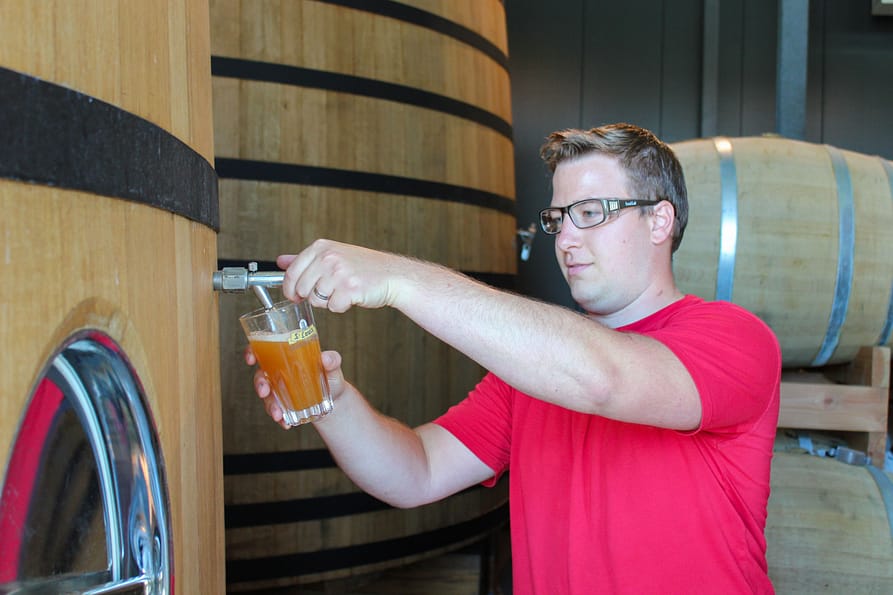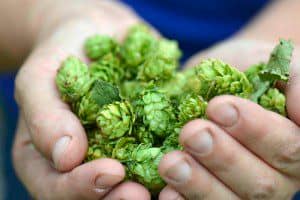If you order a freshly tapped Filou at a bar, your taste buds should be stimulated from the very first moment. Even if you enjoy a Kasteel Rouge in the sun at home or open a bottle of Kasteel Donker in the evening, the quality should always be top notch. At Kasteel Brouwerij Vanhonsebrouck, we leave no opportunity wasted during the production process to check the quality of our specialty beers. Nick Buffel, our Quality Assurance & Quality Control Manager, will tell you all about it.
When we started building a new complex in Emelgem in 2014, it was clear that we would be building the most modern brewery in Europe. “We opted for the latest technologies and state-of-the-art equipment for quality control, so that the various controls are carried out automatically. However, we leave nothing to chance and also carry out manual checks so that we can always guarantee the quality of our specialty beers. Beer is a very complex drink to produce. In the field of food safety, it is therefore very important that we examine every step of the production process,” Nick Buffel starts.
Before brewing
Water, malt, hops and yeast are the four basic ingredients for brewing beer. We rely on our suppliers to supply the raw materials. They are the first to be checked. “At first, we always check how reliable our suppliers are. If there are complaints about food safety against a supplier or if we have any complaints about the quality of the raw materials supplied, we immediately report this back to the supplier. Upon delivery, we always check the ingredients for any damage and check whether the product meets our requirements.”
“We check the hardness and acidity of the water in our own lab. For a complete water analysis, we rely on an external lab. Later in the process, the water used is microbiologically checked. ” Before the brewing process starts, we clean all pipes, tanks and installations. “This cleaning process is called Cleaning In Place or CIP. After the CIP, the final rinse water is checked for the absence of harmful microorganisms.”
During and after brewing
Once we have all the raw materials and all installations are cleaned, we start brewing. During the brewing process – mashing, filtering, boiling and cooling – the process is managed by measuring the acidity, temperature and extract contents. “After cooling the wort, we dose our unique Kasteel beer yeast. In the fermentation tank, we monitor the fermentation process by measuring the extract content. This allows us to monitor on a daily basis how much sugar has been converted to alcohol. Acidity is also an important parameter during fermentation. When the fermentation is complete, the yeast is centrifuged out and the beer can mature. This is where our lab staff measures the acidity, colour, bitterness, alcohol and extract content of the beer. Even after the preparation of fruit beer, after filtration and after filling, the above analyses are carried out on the beer to ensure that the beer meets our requirements in every step of the process. ” After filtration, we proceed to fill the beer in kegs, bottles or cans.
In the bottling plant we use return bottles and new bottles. “The new bottles are rinsed before filling and are automatically inspected to make sure they are not damaged. In the case of returnable bottles, the pH value of the residual water in the bottles is measured after cleaning to check whether they have been rinsed sufficiently. All bottles are then automatically inspected for damage, remaining dirt particles, cleaning product residues and residual water. The emissions of rejected bottles are checked every 20,000 bottles using test bottles with pre-made defects.”
Once the bottles are filled, we check the closure of the crown cap and measure the CO2 and oxygen content. “CO2 or carbon dioxide has an influence on the foamy head and taste perception, while oxygen can have a negative influence on the taste, aroma and colloidal stability of the beer.” The filled and closed bottles are then pasteurized to exclude possible contamination with yeasts or bacteria. Then we check the filling height, finish the bottles with a best-before date label, place them in crates to be palletized. “Quality control continues here as well: are all crates fully filled and is the pallet number correct so that we can always trace our beer?”
When filling the cans, it is important to check the closure for leaks. “After pasteurization, we check the filling height, the packaging and other important information such as best-before date and lot code.”
Finally, there are the kegs. These are first thoroughly cleaned before we refill them. “We check the cleaning according to the temperature and the concentration of the cleaning product. If one parameter fails in the cleaning or filling process, the keg is automatically ejected. All the keg beer goes through a flash pasteurizer before filling to eliminate possible microorganisms. After filling, we label the kegs on which you can find information regarding shelf life and more.”
Always traceable
Quality control does not only take place before, during and after brewing beer. The control continues until the beer is actually drunk. “We keep a sample of every brew in the brewery. If there are questions or remarks about a batch, we can use the code on the bottles, cans and kegs to determine the possible problem. We know exactly for each batch which raw materials we have used and from which supplier they came. In this way, we always guarantee the quality of our specialty beers,” concludes Nick.



